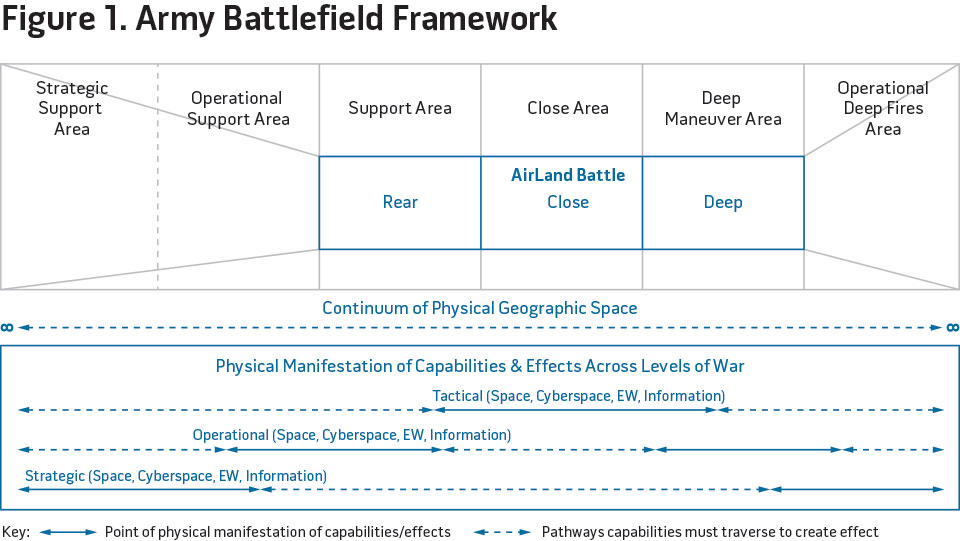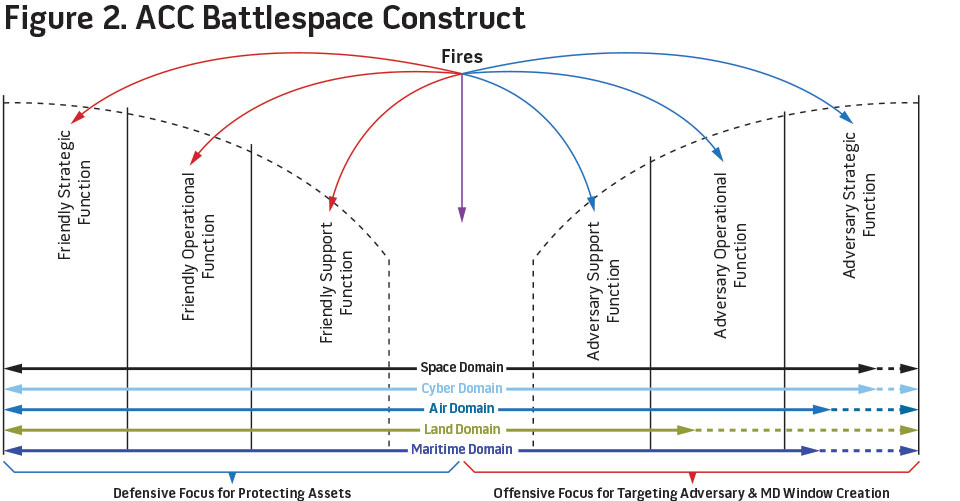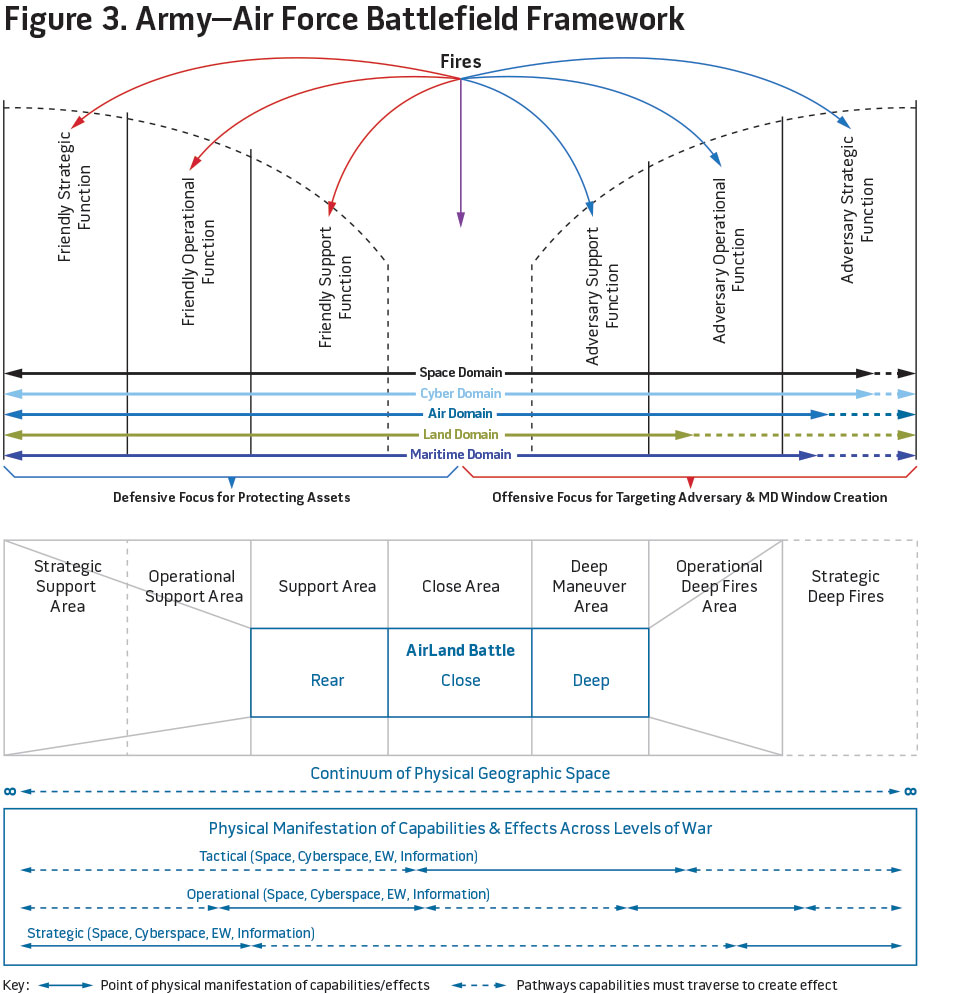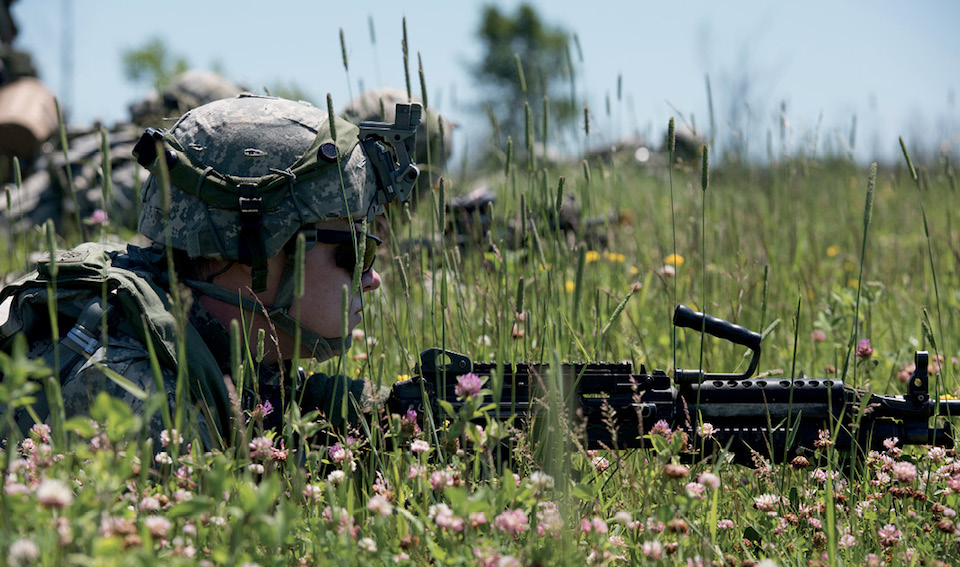Download PDF
General David G. Perkins is the Commanding General of U.S. Army Training and Doctrine Command. General James M. Holmes is Commanding General of Air Combat Command.
The mission of the Department of Defense (DOD) is to provide the military forces needed to deter war and to protect the security of the Nation. To accomplish this mission, the various Services within DOD—individually and collectively—must be trained and ready today, while simultaneously preparing for evolving threats in the future. Historically, each Service (the Army, Marine Corps, Navy, Air Force, and Coast Guard) has pursued separate and unique conceptual approaches to the dual requirements of deterrence and protection. These differences have been based largely on each Service’s primary operational domain—the limitations and opportunities presented by operating on land, on the sea, and in the air. We would then try to synchronize a series of federated solutions, developed somewhat in isolation to deal with the problems posed in a specific domain, into a joint solution. But as advancements in cyber and the electromagnetic spectrum, robotics, artificial intelligence, nanotechnology, biotechnology, three-dimensional printing, and a host of others continue to accelerate and proliferate across multiple domains, and as our potential adversaries adjust their strategies by utilizing these advancements asymmetrically in order to counter our strengths, we can no longer develop domain-specific solutions that require time and effort to synchronize and federate.
The purpose of this article then is to describe what the U.S. Army Training and Doctrine Command (TRADOC) and Air Combat Command (ACC) are doing to provide input to the Army and Air Force, collaboratively, to integrate and converge their individual land and air domain capabilities in order to create the merged multidomain capabilities that will be required for success in future combat.

U.S. Air Force CV-22 Osprey participates in U.S. Special Operations Command Exercise Emerald Warrior, Avon Park, Florida, March 7, 2017 (U.S. Air Force/Keifer Bowes)
Multidomain Battle: A New Concept for a New World
Our potential adversaries have studied our battlefield successes since the First Gulf War. It is now clear that they have learned three macro lessons. First, do not let the United States and its allies gain access to the area of operations. Once established, we have the operational advantage and can provide overwhelming logistic, firepower, and command and control (C2) support. Second, try to fracture our operational framework by isolating the air domain from the land domain in order to defeat air and land forces in sequence. Third, fix us and do not allow our forces to maneuver and bring all of our elements of combat power (including leadership) to bear in order to gain a position of advantage.
In the future, we can expect all domains to be contested. Future adversaries will possess significant integrated defense capabilities, integrated air defenses, and long-range fires, as well as sophisticated intelligence, surveillance, and reconnaissance (ISR); offensive and defensive information; electronic warfare; and cyber capabilities. It will no longer be possible to maintain total domain dominance in all domains all the time.
Multidomain battle (MDB) is a concept designed to address this changing world. We must be able to get past our adversary’s integrated defensive capabilities, avoid domain isolation and fracturing, and preserve our freedom of action. We must be able to penetrate their defenses at a time and place of our choosing, in more than one domain, by opening windows of domain superiority to allow maneuver inside our adversary’s integrated defense. The rate and speed of current and future world events will not allow us the time to synchronize federated solutions. In order to present the enemy with multiple dilemmas, we must converge and integrate our solutions and approaches before the battle starts. We must also become sensor-shooter agnostic in all our platforms, and we must develop a common operating picture.
The Army Operational and Battlefield Framework
The Army’s mission is to fight and win the Nation’s wars by providing prompt, sustained land dominance across the full range of military operations. An operational framework is a cognitive tool used to assist commanders and staffs in clearly visualizing and describing the application of combat power in time, space, and purpose (see figure 1). It then provides an organizing construct for the commander to apply resources and capabilities. The framework also guides the Army in developing capabilities and echelons of command to apply combat power and achieve given purposes as well as develop doctrine to execute the concept. The Army’s operational and battlefield framework is, by the reality and physics of the land domain, generally geographically focused and employed in multiple echelons.

The Army’s objective with this concept is to define problems as multidomain and multifunctional from the start and to develop converged and integrated solutions that do not allow any domain to go uncontested.
The ACC Proposed Air Force Operational Framework
The mission of the Air Force is to fly, fight, and win—in air, space, and cyberspace. With this in mind, and with the inherent flexibility provided by the range and speed of air, space, and cyber power, the ACC construct for visualizing and describing operations in time and space has developed differently from the Army’s (see figure 2). One key difference between the two constructs is that while the Army’s is based on physical location of friendly and enemy assets and systems, ACC’s is typically focused more on the functions conducted by friendly and enemy assets and systems. Focusing on the functions conducted by friendly and enemy forces allows coordinated employment and integration of air, space, and cyber effects in the battlespace to protect or exploit friendly functions while degrading or defeating enemy functions across geographic boundaries to create and exploit enemy vulnerabilities and achieve a continuing advantage. These efforts are typically centralized and planned within the single echelon of an Air Operations Center and led by the Combined Forces Air Component Commander.

The Air Force and Army share a common belief in the first order principles of defining problems as multidomain and multifunctional from the start, maintaining a high operational tempo driving the adversary to be reactive and denying sanctuaries from which an adversary can safely operate.
Impacts of the Differing Frameworks
The Army’s multi-echelon framework is designed to create freedom of action, generate rapid tempo, and optimize the use of available combat power. Capabilities that could not be used effectively or that would encumber lower echelons are retained at higher levels in order to allow lower echelons to focus on the extremely demanding lethal and physical aspects of close and deep operations. Higher echelon headquarters create the conditions for subordinate echelons to succeed.
Mission command is a principle of unified land operations that blends the art of command and the science of control. It relies on cohesive teams built through mutual trust, a shared understanding of the commander’s intent, the exercise of disciplined initiative, mission-type orders, and the acceptance of prudent risk. The focus of C2 becomes the purpose of the operation rather than the details of execution.
The Air Force’s single-echelon framework strives for the same results as the Army’s multi-echelon approach of rapid tempo. However, due to the inherent reach, speed, and flexibility of air, space, and cyber assets, the Air Force has the ability to disperse forces for protection while still maintaining the ability to mass forces in execution to achieve coordinated and integrated effects. These factors create the need for a more centralized C2 structure for rapid planning of integrated missions. From the plan, orders that provide effects throughout all functions of the adversary’s system are delivered to the vastly dispersed friendly forces.
These frameworks have worked separately over the past 30 years. Recent advancements by peer adversaries across the globe, including exquisite ISR capabilities, ubiquitous long-range fires, and sophisticated integrated defenses, drive a requirement for the Services to adopt a new framework to achieve a continuing advantage in a contested, degraded, and operationally limited environment.
Army–Air Force Framework Convergence and Integration
Victory in future combat will be determined by how successfully commanders can understand, visualize, and describe the battlefield to their subordinate commands, thus allowing for more rapid decisionmaking to exploit the initiative and create positions of relative advantage.
In the coming year, the Army and Air Force will be conducting a series of experiments and initiatives to help determine the essential components of MDB C2. Between the Services there is a common understanding of the future operational environment, the macro-level problems that must be addressed, and the capability gaps that currently exist. Potential solutions require us to ask questions differently, to ask different questions, and in many cases to change our definitions. For example, the Services are discovering that interoperability of information does not mean having the same hardware or even the same processes or frameworks—rather it means a shared appreciation of C2 as a weapon system, a common sense of which data are critical, and how to protect and leverage that data to gain and maintain positions of relative advantage. Frameworks will tend to merge—not as an either/or binary choice—but as a realization that effective cross-domain operations on the land and sea, in the air, as well as cyber and electromagnetic domains will require a merged framework and a common operating picture.
The Army and Air Force currently have somewhat differing perspectives on mission command versus C2 and on a battlefield framework that is oriented on forces and geography versus one that is oriented on function and time. But these perspectives are not mutually exclusive. In fact, there is significant room for convergence and integration between the two (see figure 3).

The only noncommon area between these two frameworks is the Air Force’s Adversary Strategic area. This area could easily be accommodated into the Army’s existing framework with the addition of Strategic Deep Fires—an area over the horizon beyond the range of land-based systems, thus requiring cross-domain fires from the sea, air, and space.
The Army and Air Force have been here before. The two Services had a shared understanding of the problem set coming out of the Vietnam War and the need to develop a new warfighting doctrine. AirLand Battle Doctrine, developed during the 1970s and 1980s, was the result of rigorous experimentation and intellectual debate that resulted in a shared understanding of the new battlespace.

Soldier with Alpha Company, 3rd Battalion, 172nd Infantry Regiment, 86th Infantry Brigade Combat Team (Mountain), Vermont Army National Guard, prepares assault during annual training at Fort Drum, New York, June 24, 2015 (U.S. Air National Guard/Sarah Mattison)
Conclusion
TRADOC and ACC are working collaboratively today to blend their warfighting concepts into a joint doctrine for the future. We recognize that we must address our mindset across DOD by changing our cultures to one of inclusion and openness—true jointness. We must shift from a model of interdependence to one of integration, which includes flexible C2 designs, better integrated communications systems, and development of tailorable and scalable units, and, in key areas, policies that enable adaptability and innovation. We must address technology by repurposing current technology to do more and provide greater capability, improving future acquisitions across DOD, and, most important, developing sensor-to-shooter webs.
In the future fight, we cannot depend on disparate solutions developed in functional Service stovepipes. Future commanders will have a profound breadth and depth of information and access to capabilities providing cross-domain effects, maneuver, and fires. Combat capabilities conceived and procured as disparate packages will be torn apart by peer adversaries, no matter how well they are put together on a future battlefield. Now is the time to establish the framework by which we can build the future force as a converged and integrated solution. We are developing a framework based on an informed concept, associated capabilities, and a clear articulation of requirements, thus setting the conditions to transform the military to fight and win in the increasingly complex operational environment of the future. JFQ